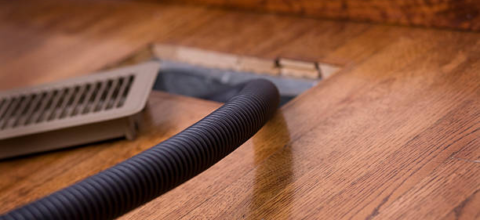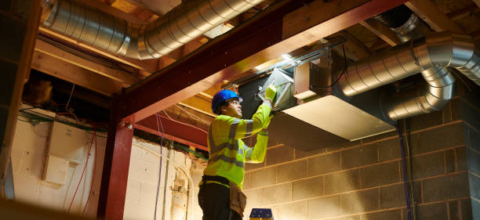Your Paramus Split-Level Has Character. What About Those Original 1960s Ducts?
Your split-level home in Paramus has a story. Built during Bergen County’s post-war housing boom, these houses offered families good space at a reasonable price. The staggered floor design fit neatly on smaller lots, and the layout worked well for the era. Split level homes pros and cons were debated even then, but most families appreciated the value these homes delivered.
Six decades later, your mid-century home still looks great. The hardwood floors, the bay windows, the clean lines, they’ve held up. But one part of your house hasn’t aged as well: the ductwork hiding behind your walls.
What’s Really Going On With 1960s Ducts?
When builders put up Paramus homes in the 1960s, they used standard materials for the time: galvanized steel ducts with basic insulation. The HVAC systems from that era were built to last 20-25 years. If your ducts are original, they’re now around 60 years old—way past their expiration date.
Galvanized steel doesn’t fall apart overnight. It breaks down slowly through rust, joint separation, and worn-out insulation. The building methods in original mid century modern house plans focused on keeping costs down, which made sense then but creates headaches now.
What Sixty Years Does to Ductwork
Metal gets tired. Those joints sealed with basic mastic back in the 60s? They crack and pull apart. Air leaks out before it reaches your rooms, forcing your system to run harder while you get less comfort. In large split level homes, this gets even more obvious because the multi-level layout already makes heating and cooling tricky.
Original duct insulation, if your system even had it, has probably compressed or crumbled by now. Ducts running through crawlspaces or attics lose heated or cooled air before it gets to you. And sixty years of dust, pollen, and debris has piled up inside those ducts. Every time your system runs, it pushes all that old stuff into your living space.
Signs Your Ducts Need Attention
Strange Smells
When your heat or AC turns on, do you smell something musty or stale? That’s disturbed dust or possible growth inside the ductwork. In a mid century duplex or homes with multi split level home plans, these smells can spread quickly through the different levels.
Dust That Won’t Quit
You clean thoroughly, but days later, dust is back. Your ducts might be spreading contamination instead of clean air. After a day at Paramus parks or local attractions, the last thing you need is more allergens circulating at home.
Uneven Temperatures
Upper level too hot in summer? Lower level freezing in winter? Temperature problems often point to leaky ducts and poor air distribution, common in aging systems in Paramus homes.
Check Your Vents
Look at your 1960 AC vents for dust buildup or dark residue around the edges. These signs mean contamination inside the system. If you can see any ductwork in your basement, check for rust, separated sections, or damaged insulation.
How to Tell If Air Ducts Need Cleaning
The typical signs show up gradually. You might notice rooms that never quite get comfortable, even when the system runs constantly. Or you dust on Tuesday and see a fresh layer by Friday. Some homeowners report higher energy bills without understanding why—leaky ducts can increase heating and cooling costs by 20-30%.
In mid-century homes, another clue is noise. Old ducts that have separated at the joints often rattle or whistle when air moves through. And if anyone in your household has allergies or respiratory issues that seem worse at home than elsewhere, your duct system might be part of the problem.
What Modern Solutions Look Like
Today’s air duct cleaning uses methods that didn’t exist when your home was built. Professionals can remove decades of buildup, seal leaks, and assess your system’s overall condition.
For homes in areas with Paramus zoning requirements, HVAC upgrades sometimes need professional assessment and code compliance. The payoff comes through better air quality, lower energy costs, and consistent comfort across all levels.
Getting Your System Evaluated
Your mid-century house deserves attention to the systems that keep it comfortable. A thorough inspection can find problems like collapsed sections, disconnected ducts, or heavy contamination that you can’t see from the outside.
Professionals who work with older homes understand how mid-century homes differ from modern construction. They can spot the unique challenges these houses present and recommend practical solutions that improve performance without compromising character.
Your split-level has given you years of good memories. Taking care of the hidden infrastructure means you can enjoy many more, with air quality that matches the care you’ve put into everything else.









